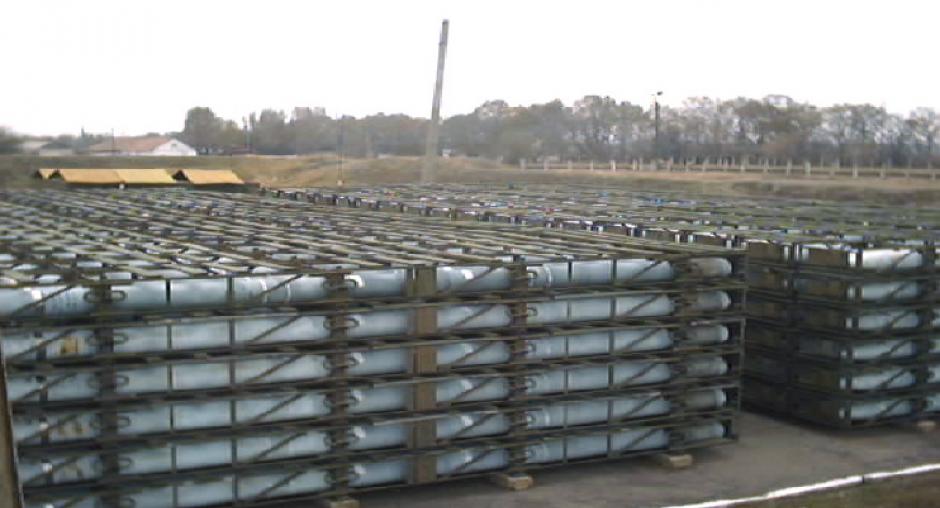Newsroom
OSCE experts visit Kaliningrad, work out plan to destroy surplus munitions
VIENNA 22 November 2005

File photo of "Uragan" missiles stored under the sky. OSCE's Forum for Security Co-operation focuses on destroying stockpiles of deteriorating surplus conventional weapons and munitions, left over from the Cold War era. (OSCE) Photo details
VIENNA, 22 November 2005 - A team of OSCE experts visited the Kaliningrad region of the Russian Federation from 15 to 22 November to work out a plan for the destruction of some 20,000 metric tons of surplus conventional ammunition, part of it in a dangerous condition.
The stockpiles of deteriorating surplus conventional weapons and munitions, a leftover from the Cold War era, include missiles, aerial bombs and anti-personnel landmines. Ageing explosives, some of which contain toxic chemicals, can be a threat to the population and environment of a whole region.
"Unless we urgently find a way to destroy these stockpiles, they can act as time-bombs," said Lieutenant-Colonel Flemming Agerskov, the Danish Team Leader of the OSCE experts assessment mission. "Stockpiles like the ones in the Kaliningrad region are lethal reminders of the past. Similar ones can still be found all across Eastern and South-Eastern Europe, as well as in the Caucasus and Central Asia."
In May 2004, the Russian Federation became the third OSCE State, after Ukraine and Belarus, to ask the OSCE Forum for Security Co-operation (FSC) for international assistance in this area. At its meetings in Vienna, the FSC receives and assesses such requests, deciding on the appropriate action to take.
The team, under the leadership of Denmark, included experts from Finland, France, Latvia, Lithuania, Poland, Sweden and the USA, as well as the OSCE's Vienna-based Conflict Prevention Centre.
They visited storage and destruction facilities in Borisov, Cherepanovo, Dolgorukovo, Ladushkin, Prokhladnoe, and Sosnovka to assess the technologies and the management capacities required to eliminate the dangerous munitions, missiles and explosives.
The team will issue shortly a report which will help define priorities and set-up a time-frame for the destruction process.
"Seeing the munitions and facilities on the ground helped us better understand the immediate threats to the security of the local population as well as to the environment. We will now need to look for potential donor countries to cover the large costs involved," added Lt. Col. Flemming Agerskov. Projects like this one depend on voluntary assistance from OSCE participating States, as well as by other international bodies.
The OSCE began addressing the problem of surplus conventional ammunition in 2003, when it adopted the OSCE Document on Stockpiles of Conventional Ammunition, so far the only international agreement addressing the risks of outdated and dangerous stockpiles.
In accordance with the OSCE concept of co-operative security, the participating States decided to establish a practical procedure, requiring minimal administrative burden, to address security, safety and environmental risks by providing assistance for the destruction and improve the security of ammunition stockpiles.
The stockpiles of deteriorating surplus conventional weapons and munitions, a leftover from the Cold War era, include missiles, aerial bombs and anti-personnel landmines. Ageing explosives, some of which contain toxic chemicals, can be a threat to the population and environment of a whole region.
"Unless we urgently find a way to destroy these stockpiles, they can act as time-bombs," said Lieutenant-Colonel Flemming Agerskov, the Danish Team Leader of the OSCE experts assessment mission. "Stockpiles like the ones in the Kaliningrad region are lethal reminders of the past. Similar ones can still be found all across Eastern and South-Eastern Europe, as well as in the Caucasus and Central Asia."
In May 2004, the Russian Federation became the third OSCE State, after Ukraine and Belarus, to ask the OSCE Forum for Security Co-operation (FSC) for international assistance in this area. At its meetings in Vienna, the FSC receives and assesses such requests, deciding on the appropriate action to take.
The team, under the leadership of Denmark, included experts from Finland, France, Latvia, Lithuania, Poland, Sweden and the USA, as well as the OSCE's Vienna-based Conflict Prevention Centre.
They visited storage and destruction facilities in Borisov, Cherepanovo, Dolgorukovo, Ladushkin, Prokhladnoe, and Sosnovka to assess the technologies and the management capacities required to eliminate the dangerous munitions, missiles and explosives.
The team will issue shortly a report which will help define priorities and set-up a time-frame for the destruction process.
"Seeing the munitions and facilities on the ground helped us better understand the immediate threats to the security of the local population as well as to the environment. We will now need to look for potential donor countries to cover the large costs involved," added Lt. Col. Flemming Agerskov. Projects like this one depend on voluntary assistance from OSCE participating States, as well as by other international bodies.
The OSCE began addressing the problem of surplus conventional ammunition in 2003, when it adopted the OSCE Document on Stockpiles of Conventional Ammunition, so far the only international agreement addressing the risks of outdated and dangerous stockpiles.
In accordance with the OSCE concept of co-operative security, the participating States decided to establish a practical procedure, requiring minimal administrative burden, to address security, safety and environmental risks by providing assistance for the destruction and improve the security of ammunition stockpiles.
